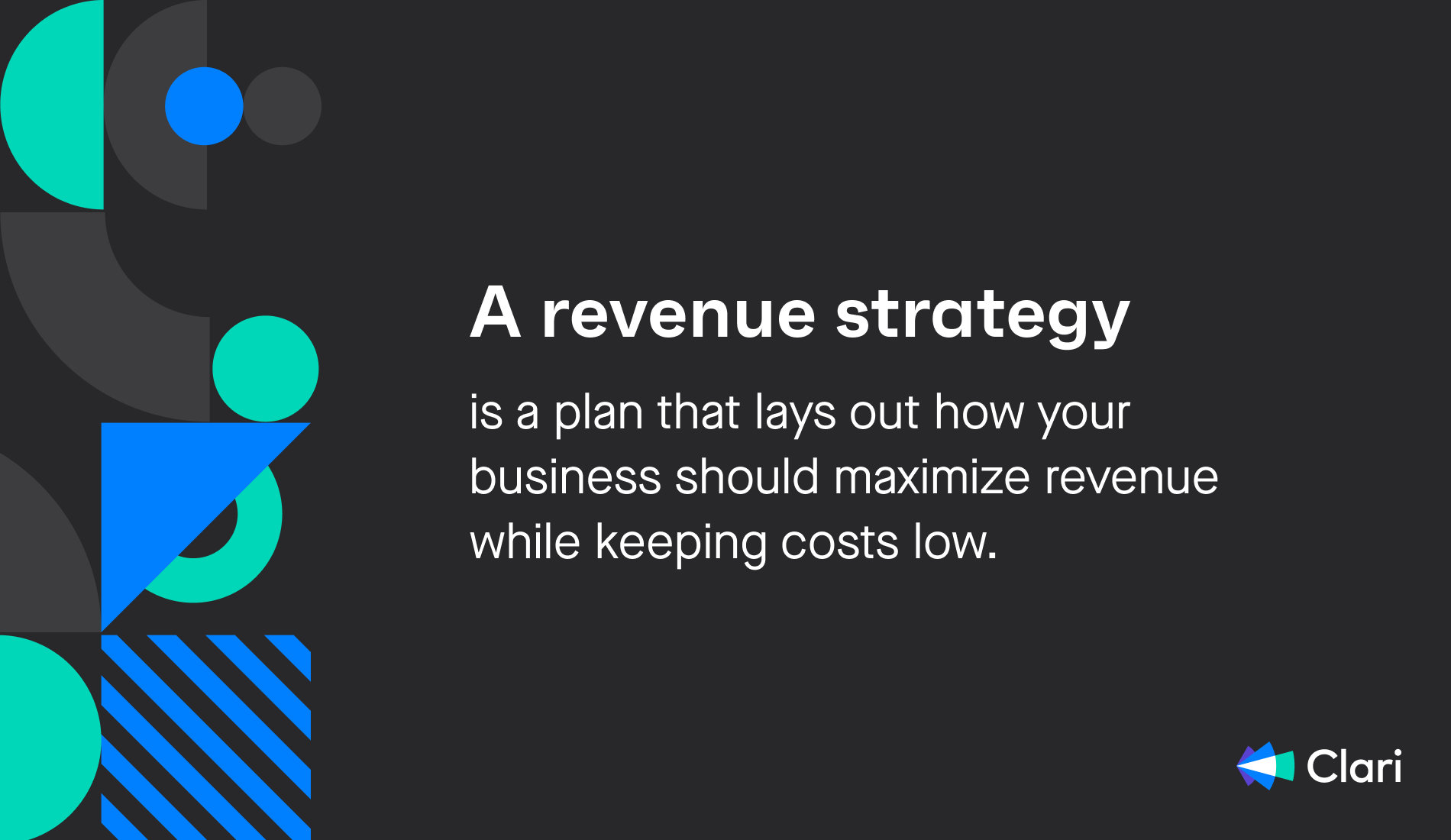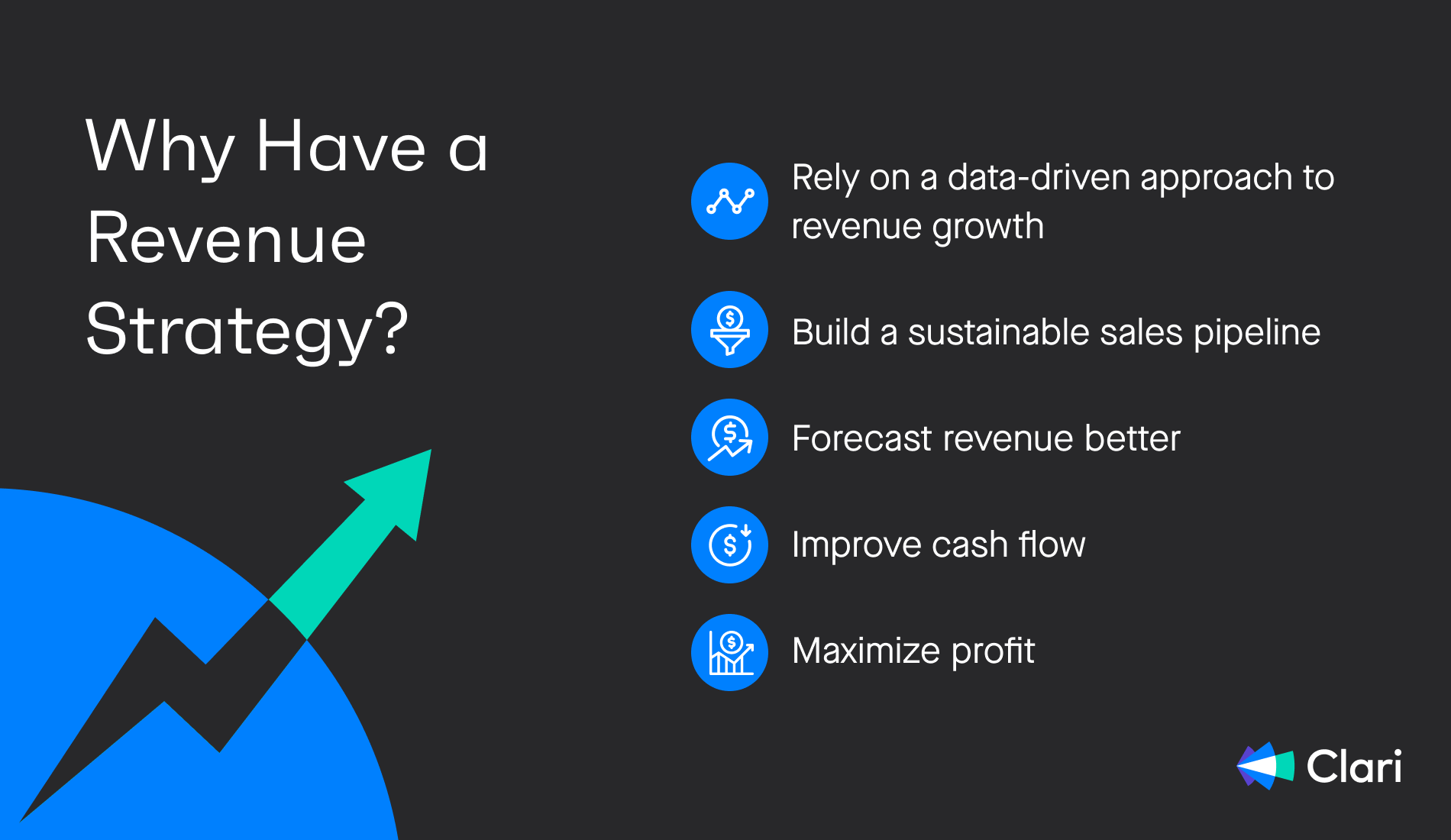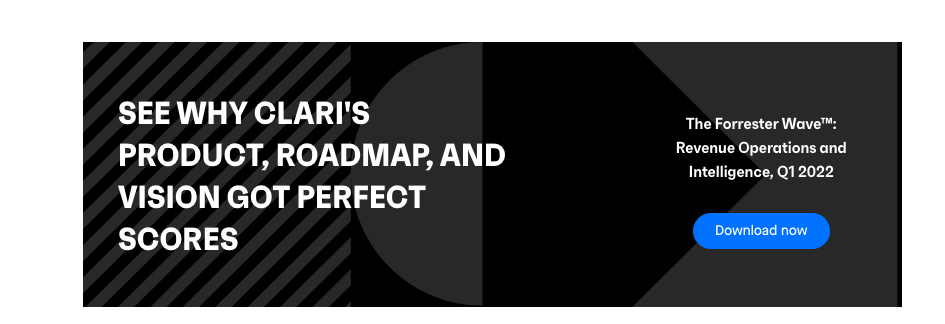Trying to double down on your revenue goals?
Instead of putting in more hours to make it happen, there’s a better solution.
You need to look inward at what matters: your revenue strategy.
You could have the best product in the world. But, if you’re not optimizing your revenue, you will be spinning your wheels for a long time.
Focusing on revenue is the most important part of building a profitable brand.
A revenue strategy is a roadmap you follow to maximize your profit margins from existing customers, generate new leads, and keep expenses low.
In this guide, you’ll learn what a revenue strategy is, why it’s important, the different strategies you can use, and examples of how it works so you can break through your revenue goals.
Table of content:
- What is a revenue strategy?
- Why is having a revenue strategy important?
- How do you develop a revenue strategy?
- 7 Revenue strategies to drive growth
- 2 Revenue strategy examples
- What revenue strategy performance metrics should you track?
- How Clari can kickstart your revenue strategy
What is a revenue strategy?
If you want to hit your revenue goals, you have to have a proven plan.
This is true in marketing, accounting, sales, customer service, and revenue operations.
A revenue strategy outlines how your business should maximize revenue while keeping costs low.

It combines a variety of activities designed to increase revenue like:
- Marketing
- Pricing strategies
- Customer success
- Product development
A revenue strategy is about getting more customers to buy your products and having control over the entire revenue process. This means turning prospects into leads, turning leads into customers, and turning customers into lifetime fans.
By implementing short- and long-term goals and mapping out the right tactics, you can drive revenue and reduce expenses to maximize profits.
An effective revenue strategy is every business owner's primary goal.
Why?
It’s all about profitability. Unlike revenue operations, you’re not just looking to drive revenue with a “revenue strategy.” Instead, you’re doing two things at once:
- Boosting revenue
- Shrinking costs
This two-pronged approach accelerates your business growth faster than any other strategy.
Why is having a revenue strategy important?
Why is having a revenue strategy important?
Imagine playing a board game to make as much money as possible. You wouldn't just run around doing random things, right? You'd have a plan.
That's what a revenue strategy is all about. It's your game plan for making more money, saving costs, and keeping your business sustainable in the long run.
Here's why it's so important:

Rely on a data-driven approach to revenue growth
You can’t rely solely on your gut or intuition when making marketing decisions. A sound revenue strategy gives you insights into what’s working and what isn’t.
For instance, it helps you analyze customer behavior, sales data, and market trends and adjust your strategies accordingly.
That way, you’re not firing arrows in the dark. You’re making calculated marketing decisions, maximizing your chances of achieving the desired outcomes.
Build a sustainable sales pipeline
A solid revenue strategy helps you create a steady flow of sales.
You can better align your sales efforts by understanding your target audience and defining clear objectives. This leads to a consistent influx of leads, providing stability to your sales pipeline.
Forecast revenue better
You don’t have historical data, sales projections, and market trends without a revenue strategy.
All that helps you accurately forecast revenue and allocate your resources accordingly.
Improve cash flow
Another reason you want a comprehensive revenue strategy is because it optimizes your cash flow. No business can survive, let alone thrive, without adequate cash inflow.
Revenue optimization helps you maximize cash inflows and minimize outflows.
Maximize profit
Unless you’re a non-profit, the sustainability of your business relies on its profitability.
Profit maximization becomes much easier with a long-term revenue optimization plan.
How do you develop a revenue strategy?
Developing a revenue strategy is like setting up a roadmap for your business’s financial success. It’s about figuring out where you want to go and how you’ll get there.
To develop an effective revenue strategy, you need to:
- Understand your target customer in depth
- Analyze market trends
Every business is unique. Your exact action plan while developing a revenue strategy will depend on your situation.
Here’s a step-by-step revenue strategy to help you move in the right direction.
Define business goals
The success of your business is dictated by whether or not it’s achieving its long-term goals.
“Long-term” is the keyword here. Focus on the bigger picture when you’re setting a goal for your business. And it doesn’t have to be “revenue growth.”
The goal could be:
- Entering a new market
- Making more repeat customers
- Working on a recurring revenue stream
When you have a clear goal, identifying the exact steps becomes easier.
Identify target markets
Most brands focus on potential customers when trying to grow their revenue.
Your past and current customers are just as important, if not more. The key to revenue growth is understanding and meeting their expectations.
Potential customers
Knowing your potential customers’ demographics isn’t enough. It also involves:
- Evaluating their online behavior through testing
- Collecting first-party data through surveys and interviews
If you’ve already developed your Customer Avatar, you know a lot about your potential customers.
However, testing is a perfect way to ensure you invest your resources in the right people.
Current customers
Your existing customers are your most valuable assets. Why? You have a much higher chance of selling to an existing customer than acquiring a new one.
And let’s not forget this: for most businesses, customer acquisition costs are generally higher than customer retention costs.
So, by focusing on your existing customers, you can improve your revenue growth. Not only that, but you can use them to improve your offerings through direct feedback. And, with word-of-mouth marketing, your happy customers act as your brand ambassadors.
Delighting your existing customers is a sure-shot way of attracting new ones. So study your current customers and invest in improving their post-sale experiences.
Past customers
Past customers provide an excellent opportunity for retrospection. You can look at your past failures and successes to inform your future strategies.
For instance, uncover the reasons why someone stopped buying from you.
Understanding all three segments of your target market—potential, current, and past customers—will help you make informed marketing and sales decisions.
Examine current offerings
Examining your current pricing structure is another way to improve your future revenue.
Use A/B testing to identify the most converting price for a product. This means trying to sell a product at different price points and tracking sales revenue.
You can do a range of other things to examine your current offerings:
- Identify customers who are willing to pay premium prices for your products
- Find products that are more frequently purchased
- Evaluate the impact of discounts on your revenue
- Understand your competitors’ pricing strategy
Find new opportunities with your pricing structure
A quick audit will reveal room for improvement even if you think you have a great pricing strategy.
Here’s what you can do to drive revenue growth by optimizing the pricing structure of your company:
- Implement dynamic pricing based on competitor research and customer behavior
- Generate more sales by offering volume discounts
- Package relevant services at a discounted price
- Make it easy for prospects to contact you if they need a customized plan
In addition, if a segment of your customers is investing in your product for specific features, offer them as standalone services.
Set revenue targets
Deciding on an action plan becomes easier when you have a clear goal in sight. But before you start working on your revenue goals, ensuring they’re realistic is crucial.
Start by reviewing your brand’s past performance to gauge future potential.
Plus, identify high-impact strategies so that you can focus your resources on them.
Lastly, identify your key performance indicators (KPIs) and constantly track your progress.
Common KPIs in SaaS businesses are:
- Cost per acquisition
- Customer lifetime value
- Cost per lead
- Customer retention rate
- Return on ad spend (ROAS)
- Return on investment (ROI)
Look at these metrics before setting your long-term revenue goals.
Set expense targets
You want to maximize the gap between the cost of running a business and its revenue.
Setting expense targets helps you allocate your resources wisely. Start by understanding your costs in various areas of your business. Having a revenue goal will also help you in setting expense targets.
When you have the right information and a clear goal, set expense targets for specific areas of your business, such as:
- Operational costs
- Marketing expenses
- Research and development
PRO TIP
Don't just track your revenue. Track expenses every month. Focus on profitability with every marketing campaing.7 Revenue strategies to drive growth
Let's dive into seven proven revenue strategies to make more money, keep costs down, and grow your business. Each of these strategies is a secret weapon you can use to help you win the game of business.
1. Find your top revenue drivers (80/20 rule)
One of the first things you should do is identify your top revenue drivers.
For example, software companies may use a subscription model (SaaS) or ad revenue from free signups. Let’s say your biggest revenue source is your subscription customers. Find the exact strategies that are driving those conversions. They could be:
- Lead nurturing through email marketing
- Organic social media marketing
- Search engine ads
Identify your highest-performing acquisition strategy and double down on it.
2. Improve sales ramp time
Sales ramp time is required to convert a new sales rep into a high-performing professional who consistently hits sales targets. Reducing the sales ramp time is a powerful way to boost your brand’s revenue growth.
Minimize your ramp time with the following strategies:
- Streamline your onboarding process
- Let high-performing reps train newbies
- Only hire skilled professionals
- Offer ongoing support and feedback to new hires
3. Hire strategically
Hiring without considering the long-term picture is a mistake many founders make. You’ll find businesses hiring employees because of a gap to fill.
What you want to do instead is forecast your future needs first.
For instance, let’s say you hire two sales reps. And in a few months, your sales team has doubled your revenue. As a result, there is a growing need to hire some customer service reps.
Strategic hiring helps you invest your resources in the right people at the right time.
4. Improve CLV with cross-selling and upselling
Customer lifetime value (CLV) is the value (or revenue) each customer brings. You can use cross-selling and upselling to maximize your CLV.
- Cross-selling is when you promote an additional product after someone makes a purchase.
- Upselling refers to introducing a higher-priced product right after someone purchases a lower-priced one.
For instance, let’s say someone is on the basic plan of your SaaS that offers limited automation. You can introduce a higher-tier plan with more automation features.
5. Explore a partner sales model
Hiring and training sales reps takes time and resources. A partner sales model helps you get quick revenue boosts.
In it, you work with other businesses and marketers. They promote your product in exchange for a commission or percentage. The downside is that you may earn a little less than usual. But the strategy offers quick results and reduces your sales costs.
6. Double down on your best customer segments
Think about the type of customers that bring you the most income.
For instance, you may have different clients, from freelancers to marketing agencies. So, if agencies are your top revenue drivers, double down on this customer segment for a boost in revenue growth.
7. Focus on customer retention for recurring revenue
A mistake many businesses make is that they focus most of their resources on acquiring new customers. As a result, their existing customers get ignored.
The fact of the matter is many startups see better revenue growth by working on customer retention than they do with customer acquisition.
PRO TIP
Lean into your current customer base to drive your revenue strategy. Your lifetime value to customer acquisition cost ratio increases every time a customer buys again.2 Revenue strategy examples
Now, let's look at two real-life examples of businesses that implemented a revenue strategy successfully:
Service packaging (Marquet Media, LLC)
Packaging your services lets you build more predictable revenue streams.
Marquet Media, LLC, a PR agency focusing on wellness brands, implemented this revenue strategy.
First, they analyzed their target market and developed their Ideal Customer Profile (ICP). Next, they understood the audience's main pain points and packaged the services to address them.
The result?
Marquet Media experienced a 15% increase in annual recurring revenue (ARR).
Service diversification (Corporate Filming)
Diversifying your services is an effective way to stand out in a competitive market.
Here’s how Corporate Filming used this revenue strategy:
They first discovered the top concerns the target market faces and addressed them. For instance, customers didn’t like the complicated pricing structure. Corporate Filming then came up with simple annual pricing.
Since implementing this change, Corporate Filming experienced 900% growth in revenue.
What revenue strategy performance metrics should you track?
To make sure your revenue strategy is working great, you can track some key metrics—think of these as the scoreboard of your business board game.
Here’s what you should keep an eye on to ensure you’re hitting your goals:
Total revenue
The most obvious one is your total revenue. Monitor your revenue growth and see if you’re meeting your targets.
Total expenses
Revenue growth is great, but it's useless if it’s not increasing your profit margins.
Your profit is equal to total expenses minus your revenue. When your expenses are high, the profit drops.
Optimize your expense strategy and ensure you’re not spending more than you should.
Return on ad spend
ROAS is usually pretty high when considering the long-term revenue from recurring sales. So, if you’re trying to get new customers through advertisements, setting a low ROAS target is okay.
Regardless of low or high, track this metric to ensure your ads generate enough results for you.
Average profit margin
Your average profit margin depends on the cost and price required to produce the product.
Even if you’re getting a high ROAS, it’s no good if your profit margins are too thin.
Customer lifetime value
Customer lifetime value (CLV) is the average revenue you generate from each customer over their lifetime. It depends on your product’s price and how long an average customer pays for it.
For instance, if your product costs $30 per month and an average customer uses it for two years, its CLV would be:
$30 x 12 months x 2 years = $720 CLV
Average order value
AOV is the average revenue you generate with a single sale. It usually stays the same unless you introduce a discount.
An effective way to improve your AOV is by gradually increasing the price.
Customer acquisition cost
You need to optimize your marketing costs to keep your revenue graph pointing upward.
By tracking CAC, you’re in a better position to optimize your marketing strategies and focus on what works best.
How Clari can kickstart your revenue strategy
When growing your business, having a clear path helps you stay focused and motivated.
When you have a revenue strategy, you can:
- Better utilize your resources
- Forecast revenue
- Build a sustainable sales pipeline
- Optimize your cash flow
- Boost profits
Ready to improve your revenue and maximize profit simply and painlessly?
Clari can help!
Clari is a revenue platform that simplifies and accelerates your revenue growth.
With various built-in revenue management features, you’ll gain valuable business insights that will help you pull the right revenue levers to grow your business.
Sign up for a demo now and see the difference it can make for your business!



